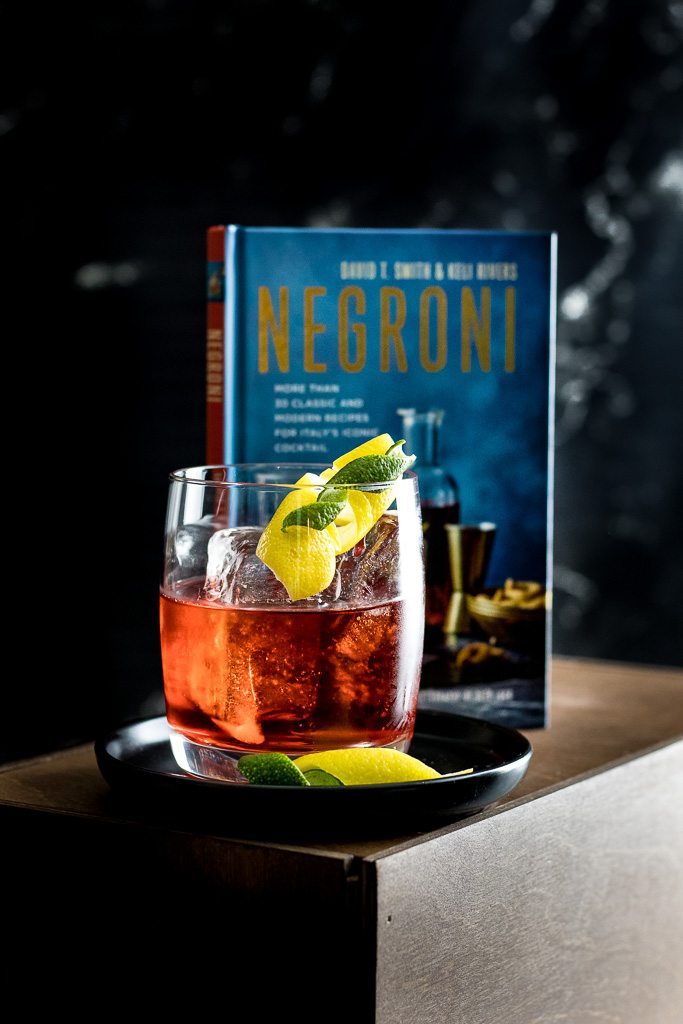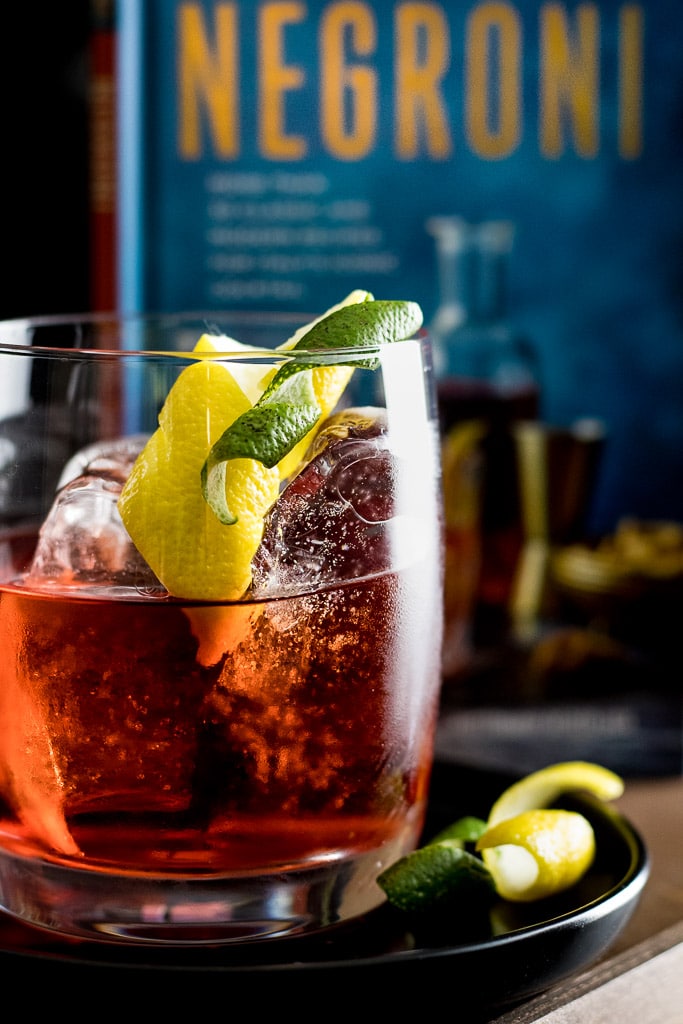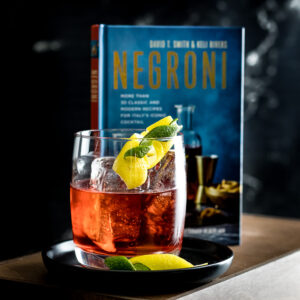Last Updated on December 1, 2021 by Heather Wibbels

I came to the Negroni via a side door – the Boulevardier. As a bourbon fanatic Campari’s red bitterness and bourbon’s sweet heat made me backtrack to the original version: the Negroni. Because I love reading about cocktails almost as much as making them, reading through the short book Negroni by David T. Smith and Keli Rivers was a fun, and approachable exploration of the classic cocktail and its descendants. (I was provided with a free promotional copy of the book via Bevfluence but the opinions below are my own).
(Post may contain affiliate links.)
This cocktail recipe book from Ryland Peters & Small includes beautiful pictures and short descriptions of over 30 variations on the classic Negroni. The text lists specific vermouths, gins, and spirits, but the Negroni thrives on variations of brands or spirits.
While David T. Smith is a Gin Hall of Fame recipient chair of gin judging for the American Distilling Institute (among others) and frequent spirits author, Keli Rivers is a ‘ginnoisseur’ spreading the gospel of gin in her tole as US Brand Ambassador for Sipsmith. As such, both are in the business of thoughtfully consuming and writing about Negronis. Both had wanted to write a book together, and the Negroni was the perfect topic for their collaboration.

For my bourbon and whiskey drinkers perhaps I should start with a quick definition of the Negroni. It was first recorded in print in 1919 by a Forsco Scarsell in Cafe Casoni in Florence for a ’Count’ Camilio Negroni (he may or may not have been an actual count). Originally it was a stronger version of the drink we refer to as an Americano cocktail today. By 1955 it had transformed into its now standard equal parts recipe of gin, Campari, and sweet vermouth.
The Boulevardier, its bourbon cousin, was created by a patron of Harry McElhone’s New York Bar in Paris during Prohibition. The patron, Erskine Gwynne, ran a gentleman’s literary magazine called The Boulevardier (roughly translated “man about town”). So the cocktail was named after his publication. More information here on How to Make Your Boulevardier Perfect.
I enjoyed the book’s easy organization by classic, white, experimental, and seasonal Negroni categories. For newcomers to the cocktail, the classic section is a perfect introduction to variations on the theme. The pictures of the cocktails in the book are beautiful and well-styled. The design of the book and the layout kept the recipes easy to read and follow.
The Negroni is ubiquitous and doesn’t require a lot of fancy or unusual ingredients. Keli said, “The Negroni is classic for a reason- it is better than the sum of its parts. Three ingredients, equal amounts, a bit of dilution, a whole lot of love, and voila, a classic. Its popularity has a lot to do with the fact that 99% of all bartenders know the drink, you could order it anywhere and pretty much get a delicious cocktail! From a 3 star restaurant to a neighborhood pub the Negroni is always available.”
And as it is always available with the three simple elements, variations on that theme are nearly endless.
When I asked Keli about preferences with different Negroni variations, she said, “I have always been a classic when it came to my Negronis. . . However every day for the whole month of March (my birthday month) I would go to a different San Francisco bar or restaurant and just ask the bartender for a “Negroni” without any qualifiers and see what they would make. I didn’t care for them all however, it was a fun way to see the creativity of my fellow bartenders!”
For me, the most enjoyable were experimental variations with different base spirits, like the Oaxacan, which substitutes mezcal for the gin. I loved the give and take of the mezcal and Campari in the cocktail. The combination of the two made a lovely contrast of two very loud flavors. I didn’t expect it to work, but it very much did. (See below for the full recipe.)
A few weeks ago I posted a fun Suze cocktail – a Suze Sour, but it came about because I was playing with the template of the White Negroni with Suze, Lillet Blanc, and dry vermouth and wanted to experiment with Suze and whiskey. So when reading through the white Negroni category I wanted to try something different from the classic White Negroni.
So I made the Negroni Bianco Bergamotto – which used Suze, Dolin Blanco, and Italicus topped with a smidge of prosecco. It was light, herbal, and tied the floral notes from the gin to the bergamot-flavored Italicus to counteract the bitter gentian punch of the Suze.
In fact, given the Suze variation of the White Negronis listed in the book, I’m also tempted to try the classic Batched Negroni chilled as a base for champagne or sparkling cocktails. As a fan of batched cocktails, I love using them in ways you might normally use a spirit or liqueur. And creating a refrigerator back of Negroni is just good sense when you want to play with herbal or alpine flavors that connect well to herbal or piney flavors and aromas.

The book was limited in scope, and the authors wanted the book to be approachable to the home bartender, its intended audience, so they kept to ingredients and techniques that were readily available in both the US and the UK. Keli said, “It wouldn’t be as fun of a cocktail book if you couldn’t make all the recipes. So I suggest to try not only different gin variations but also different vermouths and bitters.”
As Keli mentioned, in the last ten years the availability of different sweet and dry vermouths, and a range of different bitters in the style of red Italian bitters means options for your perfect Negroni have expanded exponentially. And as always, experimenting with different versions of gin will affect the balance and flavor profile of the final cocktail.
I wished the book had gone more in-depth with infusions of the spirits involved, either the bitters, vermouth, or gin. I’ve had so much fun in the last year playing with my Campari infusions I expected more of those kinds of cocktails in the book. But, my idea of approachable cocktail techniques and ingredients may be a little more involved than your typical Negroni drinker.
Still, I wouldn’t hesitate to use some of my Campari infusions in these cocktail variations as a way to further develop and riff on the classic.
I’ve included the Oaxacan recipe for you below, as it was my favorite variation I tried, but if you’re a Negroni lover, this small collection of curated cocktails will lead you in fun directions with its riffs and variations.
Recommended Bar Tools
You don’t need every slick, beautiful bar tool out there, but there are several I’ll recommend. (As an Amazon Associate I earn from qualifying purchases. However, that does not affect the cost of the items below.) My favorite pieces usually come from the Cocktail Kingdom section of Amazon:
You may already have these bar essentials, but just in case:

Oaxacan Negroni
Ingredients
- 1 oz Illegal Mezcal
- 1 oz red vermouth
- 1 oz Campari
- Garnish: lemon peel strip, lime peel strip
Instructions
- Add mezcal, vermouth, and Campari to a mixing glass and fill with ice. Stir vigorously. Strain into an ice-filled rocks glass. Garnish with lemon and lime peels.